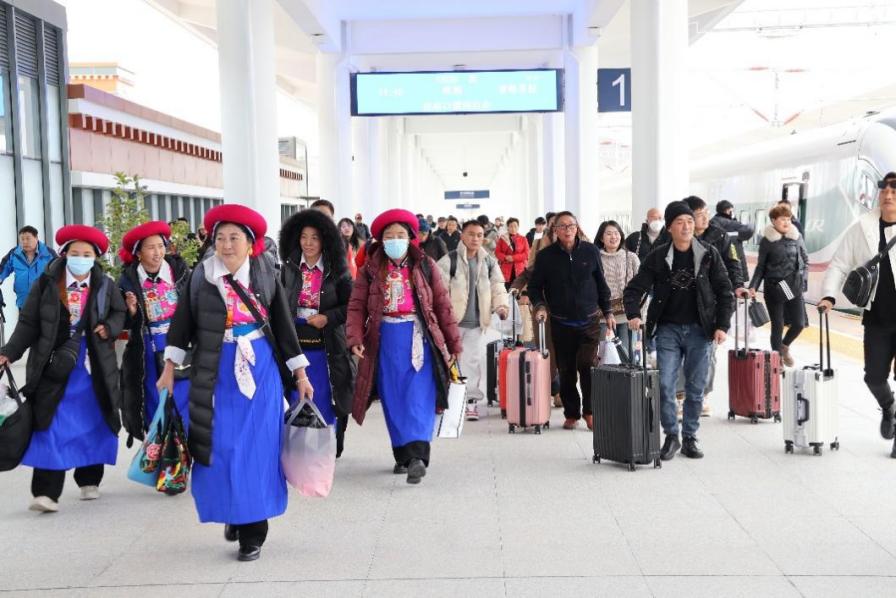Transport development brings convenience, prosperity to rural China
Shen Xiuqiao is a bridge builder who works at the construction site of the Zangke River bridge, a section of the Nayong-Qinglong Expressway in southwest China's Guizhou Province. The Zangke River bridge is expected to slash travel time between the two banks of the river from one hour to just one minute after it is completed.
Shen said his name carries the high expectations that his father has for the local transportation. The Chinese characters “xiuqiao” in Shen’s name mean "building bridges" in English.
Shen said that his father hoped that one day a bridge can be built to make it convenient for local villagers to travel, adding that his father's dream has now come true, and the lack of a bridge that could make life easier for local residents has become a thing of the past.
Guizhou, the only province in China without plains, is renowned for its towering mountains and deep valleys. The formidable terrain has historically posed obstacles to travel, and the outdated transport infrastructure significantly hindered local economic and social progress.
The Nayong-Qinglong Expressway, which is under construction, symbolizes a fast train that carries the hopes of the people in mountains for enhanced connectivity and prosperity. Furthermore, its Zangke River bridge not only facilitates smooth vehicular movement but also provides travelers with breathtaking views.

Photo shows the Zangke River bridge under construction in southwest China's Guizhou Province. (Photo courtesy of the interviewee)
China has built the world's largest high-speed railway network, the largest expressway network, and world-class port clusters. The Chinese people have experienced the changes brought about by transportation and are enjoying increasingly convenient travel services.
Data released by China's Ministry of Transport shows from January to November 2023, China's transport sector saw a fixed-asset investment of 3.6 trillion yuan ($507 billion). The country constructed 1,700 kilometers of new high-speed railways, upgraded or transformed over 7,000 kilometers of highways, and expanded the operational mileage of its urban rail transit by 360 kilometers.
From January to November 2023, the country's inter-regional passenger traffic reached 55.59 billion, and the traffic volume of the country's expressways hit 11.48 billion vehicles.
During the same period, China renovated over 160,000 kilometers of new rural roads, with an investment exceeding 455.5 billion yuan.
On Nov. 26, 2023, the Lijiang-Shangri-La Railway was officially opened to traffic. With the arrival of a Fuxing bullet train at the Shangri-La Station, located in the Diqing Tibetan Autonomous Prefecture of southwest China's Yunnan Province, the area at an average altitude of 3,380 meters became connected to the national railway network. This development finally put an end to the lack of railway connectivity in the region.

The Lijiang-Shangri-La Railway handles over 180,000 passenger trips in its first month of operation. (Photo courtesy of the interviewee)
Before the opening of the Lijiang-Shangri-La Railway, the Diqing Tibetan Autonomous Prefecture faced significant poverty. However, this transformative railway has brought about a remarkable change, propelling the region towards a modern way of life for its diverse ethnic groups.
Gerong Peichu, a Tibetan trainee conductor born in 2001, expressed his joy at the accessibility of the railway in Shangri-La. He pledged to work diligently to showcase the beauty of his hometown through the railway.
The Lijiang-Shangri-La Railway has not only made travel more convenient for the local population but also significantly shortened travel time and distances.
As a result, the time needed for goods transportation has been significantly reduced, particularly benefiting the global distribution of local beer. Moreover, the railway has enabled the worldwide availability of Matsutake mushrooms, a local delicacy harvested from the mountain forests.
The Lijiang-Shangri-La Railway handled more than 180,000 passenger trips and transported over 23,000 tonnes of goods as of Dec. 26, 2023, a month after its inauguration, according to the China Railway Kunming Bureau Group Co., Ltd.
From January to November 2023, the fixed-asset investment in the country's railway sector reached 640.7 billion yuan, a 7.4-percent increase from the previous year. As of Nov. 30, 2023, the total operation mileage of China's railway network exceeded 155,500 kilometers, including 43,700 kilometers of high-speed railways.

Rural roads make travel more convenient for rural residents. (Photo courtesy of the interviewee)
Photos
Related Stories
- AI Vibes | A Decade of China: Leapfrog development in energy and transportation sectors
- Factbox: China makes headway in transport development
- China's urban passenger trips soar 16.7 pct in first three quarters
- China Development Bank steps up loan support for transport
- China's waterway freight volume up 8 pct in Jan-Aug
- Trial of new road connecting China, Mongolia, Russia finishes
Copyright © 2024 People's Daily Online. All Rights Reserved.









